
|   |

|   |
 e-mail: sunilkothari1933@gmail.com Golden Jubilee celebrations of Sangeet Sattra Photos courtesy: Sangeet Sattra July 29, 2018 Raseswar Saikia Barbayan, the legendary Sattriya guru, established Sangeet Sattra in 1968, after he returned from Kamalabari Sattra to Guwahati. He got married and started teaching young maidens Sattriya dances. This was a revolutionary step as the celibate monks of Sattras performed in the Sattras and women were not allowed to either enter Sattras, or dance. However, realizing that there need not be any gender bias and women are equal devotees with a right to perform, his earlier students included Indira PP Bora, Sharodi Saikia and his own two daughters Ranjumoni and Rinjumoni. 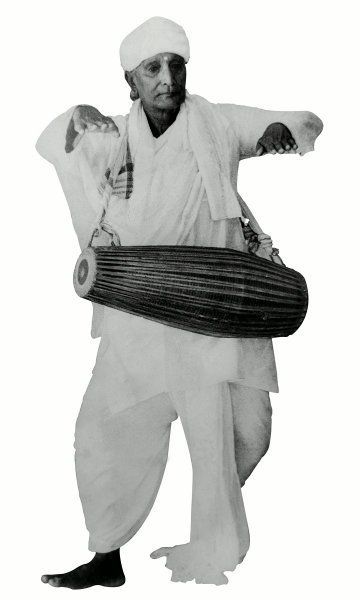
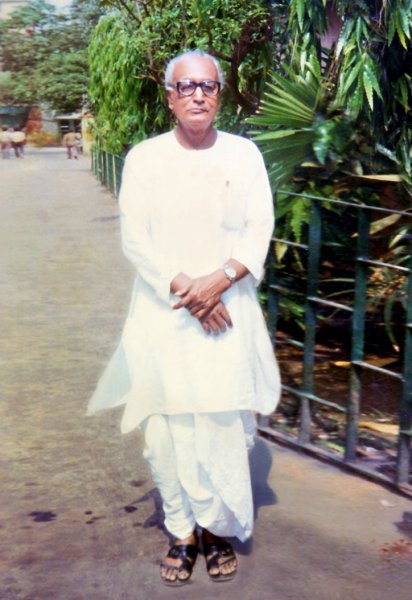
Raseswar Saikia
Raseswar Saikia was born in 1928 at Tiyok in Sibsagar District, Assam.
His father Kanakeswar Saikia offered Raseswar at the age of 7 to
Kamalabari Sattra as a devotee. The stalwarts of Sattriya gurus were
Bapuram Barbayan and Maniram Gayan Mukhtiar for singing, Saruram
Barbayan Mukhtiyar for dance and Devendranath Burabhakat and
Maniram Dutta Mukhtiyar for Bayan, khol playing. He also learnt Ojapali
from Saruram Barbayan Mukhtiyar and Ramchandra Sarma. He was thus
proficient in all aspects of Sattriya dances. He was awarded Barbayan
title in1950.He was anxious to bring Sattriya dances from the confines of Sattras to the knowledge of wider public, beyond Sattras and Assam. The conservative section of the society criticized him for his teaching outside Sattras and also to women. But Raseswar was determined to spread Sattriya culture and teachings of Saint Sankaradeva to people at large. His efforts met with success as there was also great support from intelligentsia class who shared his vision. In 1975 under his leadership, a troupe of Sattriya dancers visited Indonesia along with President Fakhruddin Ali Ahmed. The performances received great appreciation. For his services to the field of Sattriya dances he was awarded Sangeet Natak Akademi award in 1980. Later on, several honours and awards followed the award from SNA. He was familiar with other classical dance forms. He sent his younger daughter Rinjumoni to study under Guru Munna Shukla, cousin of Birju Maharaj, at Kathak Kendra. As a matter of fact, Kathak is a popular dance form in Assam. One of the young dancers, Surendra Saikia went to Lucknow to study under Vikram Singh, a disciple of Achhan Maharaj. Jaipur gharana gurus and performers like Rajendra Gangani have been conducting workshops of Kathak regularly in Guwahati. Birju Maharaj's disciple Vipul Das has been teaching Kathak in Guwahati after he graduated from Kathak Kendra. Raseswar Saikia passed away in October 2000. Prior to that under the chairmanship of Bhupen Hazarika, Sangeet Natak Akademi organized a conference to give classical status to Sattriya dances, in which Raseswar Saikia participated and demonstrated various aspects of Sattriya dances which showed that it was a classical dance form, but was not known to public as it was confined to Sattras. To strike a personal note, when I visited Kamalabari for the first time in the year 1964, it was Raseswar Saikia who had looked after me along with Ghanakanta Bora. He had demonstrated several items of Sattriya dances for my documentation. During my ten days stay, Raseswar Saikia had explained to me several aspects of Sattriya dances. In 1970, I again visited Kamalabari Sattra with Prof Richmond Farley from Michigan University and we filmed various items including Dhemali, Sutradari Nach, Dashavatara, and excerpts of Ram Bijoy Ankiya Nat. Raseswar Saikia and I remained in touch with each other. I used to give lec-dems on Sattriya dances in Mumbai at NCPA. In one of the presentations, Raseswar Saikia had accompanied Indira PP Bora. It so happened that Pupul Jaykar was in Mumbai and attended our lec-dem and honoured Raseswar. By fortuitous circumstances, Bharatanatyam dancer Hema Malini also attended the presentation. She was anxious to study Sattriya dances. Other dancers who had shown great interest in studying were Indrani Rahman and Ritha Devi. Ritha Devi studied under Guru Jatin Goswami and used to perform along with other styles like Bharatanatyam and her favourite Odissi. Sangeet Sattra organized their annual function presenting Jaipur gharana guru and exponent Rajendra Gangani in Kathak recital. He was accompanied by his younger brother Fateh Singh, the ace tablist. The vocal support was given by Jayram Medhi. Rajendra has earned fame for his excellence in Jaipur gharana nritta. With the passage of time his performances have gained maturity. There is a sense of authority when he executes movements, including pirouette on one foot taking multiple rounds. The stamina is praiseworthy and from the way he recites mnemonic syllables for tode, tukde, parans, parmelu or even kavits one feels that he has ability to conceal the hard work he has put in for years. Opening with prayer in praise of Lord Shiva, describing his cosmic form, Rajendra invested the form with great serenity and dignity - Gam, Gam Ganapati kavit, the signature prayer of Jaipur gharana. The thaat of Jaipur gharana covers a lot of space with graceful postures. I have often felt that it prepares a dance for gat nikas in a detailed form. Prior to the performance, we had a little discussion on why there is little abhinaya in Kathak. Rajendra mentioned that he usually includes compositions of Surdas which in North India are shared tradition and audience responds to it. His selection of Surdas pada was full of emotion and was rendered by Jayram Medi in a melodious manner replete with bhava. Jayram Medhi has received training in Hindustani classical music. He also accompanies his wife Marami Medhi and daughter Megharanjani who are Kathak dancers. Therefore accompanying Rajendra for his performance was perfect. Though abhinaya remained on a narrative level, it was refreshing to watch it in Rajendra's recital. One expects him to perform more abhinaya numbers in order to bring back abhinaya to Kathak performances. 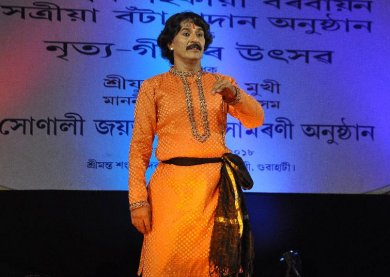 Pt Rajendra Gangani 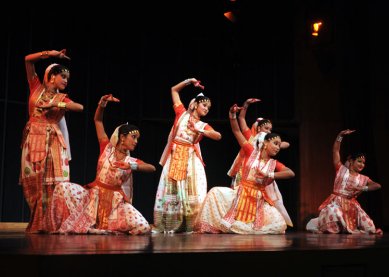 Disciples of Sangeet Sattra  Disciples of Sangeet Sattra This being the Golden Jubilee of Sangeet Sattra, Ranjumoni as the principal organizer had planned to present a large number of students to showcase their training. Dressed in colourful costumes of Assamese silk and flower designs, more than 50 dancers created a spectacular impact when they entered the stage. They formed a large circle executing various movements, gracefully bending sideways, raising arms with Alapadma hastas, weaving patterns that formed attractive designs. Instead of solo presentation of a dancer, the group presentation offered scope to choreograph the nritta number in a visually satisfying manner. Of course the tiny tots moved with their cherubic smiles, winning the hearts of the audience. Some dressed as gopa balakas, and some as gopis created illusion of Brindavan. They moved in rhythm and joyously. Sangeet Sattra's contribution over half a century is commendable. The horizontal growth of the dance can be gauged with number of young children and young girls taking to Sattriya. On second day, with auspicious beginning of the programme with the presentation of Bargita by few women vocalists, accompanied by young musicians Arunabh Jyoti Malakar, son of Ranjumoni, expert in playing khol, Manzil Kumar Gogoi on violin, Shubhabrata Saha on tabla and Dattatreya Mutalik Desai on flute was performed with perfect synchronization. The Assamese musicologists demand for the status of the music of Bargits as classical. It needs to be examined carefully and not on any sentimental basis. These are regional music forms and are a part of the music and dance scene. There is a wealth of Bargits sung by people on many occasions. Also Bargits form part of Sattriya dances for abhinaya. The duet performance by Chitralekha Gogoi and Juri Das was noteworthy for its devotional mood. Both are talented dancers. They need to be seen in other cities and other states. Upen Chandra Boruah Barbayan and his troupe from Badala Sattra, Narayanpur, Lakhimpur in their Gayan Bayan displayed their command over rhythm playing various talas using hand gestures in a group. Upen Chandra has been conferred with Barbayan for his proficiency in khol playing. Their performance was much in nature of tribute to Raseswar Saikia. The most memorable performance of mime was by that wonderful mime artist Moinul Haque. From the beginning to end enacting a boxer in the ring, hitting the opponent and in return receiving terrific blows, and losing his teeth, he kept audience in splits! What a brilliant performer he is! He needs to be seen elsewhere in India. Bravo, Moinul Haque!  Rudra Jayant Bhagwati and Pranamee Bhagwati 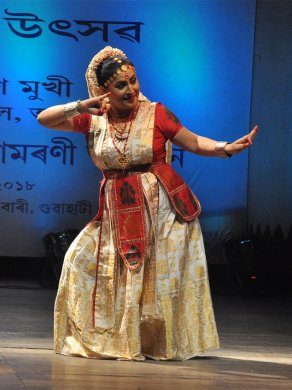 Mallika Kandali Kathak dancers Rudra Jayant Bhagwati and Pranamee Bhagwati paid tribute to Raseswar Saikia with their choice nritta numbers including tode, tukde, tatkar, tihais, parmelu and abhinaya to a song. They have been travelling abroad a lot. And their programme gave an impression of a package which would appeal and please audiences abroad. They have received training from Vipul Das in Kathak and have been winning appreciation of audiences in Assam and abroad. Despite avoirdupois Pranaame danced with grace and charmed the audiences. Rudra had coloured his hair and gave an impression of a foreigner. They would do well to dispel that impression as their roots are in India. I was told that they stay in Guwahati and perform there. Mallika Kandali is a name to reckon with in Sattriya dances. She presented her new choreography based on theme of monsoon. She always explores new themes in Sattriya within the tradition extending the boundaries of Sattriya dances for city stages. Three young dancers performed Bharatanatyam. One of them was a disciple of Indira PP Bora. Indira's disciples are a legion in Guwahati as she along with Shubhalakshmi Khan was studying at Kalakshetra and with her Kalabhumi institution has trained hundreds of dancers in Bharatanatyam. Now Indira also trains them in Sattriya dances. In the group dances of Sattriya when they performed various items of Mati Akhada like Tola, Pani Khincha, Had Bhanga, Chalona, the tiny tots excelled imitating elders looking sweet and involved. I missed the performances held on 10th July by the most popular young Manipuri dancer Sinam Basu, duets by mother and daughter Anita Sharma and Arhie Kaushik, Kathak duet by mother and daughter Marami Medhi and her daughter Megharanjani Medhi. Megharanjani has been creating waves as a film star also, with her beauty and dancing. 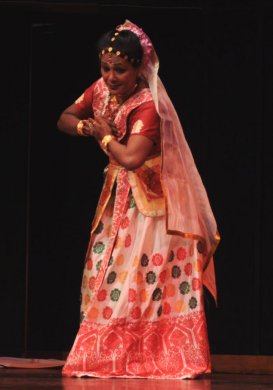 Ranjumoni Saikia 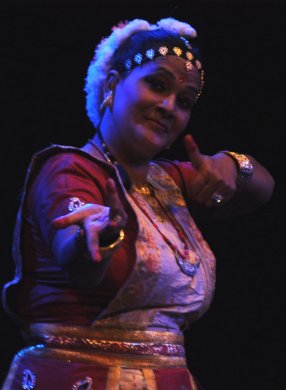 Rinjumoni Saikia Ranjumoni and Rinjumoni deserve congratulations for organizing the three day festival on the occasion of 50th year of Sangeet Sattra. Besides teaching at Sangeet Sattra, Ranjumoni is Principal of Rasaraj Sattriya Sangeet Vidyalaya. She also works at the office of the Deputy Commissioner, Kamrup (Metro). A versatile dancer, organizer, administrator and teacher, she has along with her younger sister Rinjumoni done her father proud by looking after Sangeet Sattra. Sangeet Sattra has been honouring dancers, scholars, writers in the field of dance for past few years and brings to their notice the rich cultural heritage of Sattriya dances and showing catholicity in appreciating other classical dance forms Guru Munna Shukla, nephew of Birju Maharaj, was honoured. His disciple Ruchi Saini has made a documentary on him which we could see at Ranjumoni's residence. It was a pleasure to see such a documentary unexpectedly in Guwahati. I suggest that next time when Ranjumoni arranges the festival, she should in advance get information about such documentary of the guru they plan to honour. They also honoured Samar Sharma, who has supported Sattriya dance for several years and he and his wife arrange to teach Sattriya dances at their institution. Sattriya dancer Haricharan Saikia, 88, khol player and Barbayan from Kamalabari Sattra, Prabhat Sharma well known musician from Guwahati who has been guiding Sattriya Kendra for Sattriya music, were also honoured. The annual festival was a big success and credit for it also goes to Swapnanil Barua, the former secretary, Culture, Govt. of Assam.  Dr. Sunil Kothari is a dance historian, scholar, author and critic, Padma Shri awardee and fellow, Sangeet Natak Akademi. Dance Critics' Association, New York, has honoured him with Lifetime Achievement award. Post your comments Please provide your name and email id when you use the Anonymous profile in the blog to post a comment. All appropriate comments posted with name & email id in the blog will also be featured in the site. |